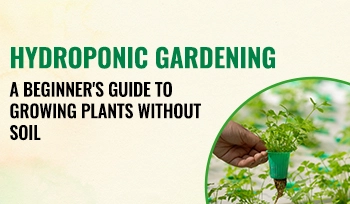
Hydroponic Gardening: A Beginner's Guide to Growing Plants Without Soil
Hydroponic gardening represents an innovative approach to plant cultivation that eliminates the need for soil, offering numerous advantages for both beginners and experienced growers alike. As one of the leading hydroponics companies in India, InHydro is committed to providing comprehensive guidance and support for individuals looking to embark on their hydroponic gardening journey.
Understanding Hydroponic Gardening:
Hydroponic gardening involves cultivating plants in nutrient-rich water solutions without traditional soil mediums. Instead, plants are supported by inert substrates like perlite, vermiculite, or coconut coir, allowing roots to access essential nutrients directly from the water solution. This method offers precise control over nutrient levels, pH balance, and environmental conditions, resulting in faster growth rates and higher yields compared to conventional soil-based gardening.
Essential Components of Hydroponic Systems:
For beginners, understanding the essential components of hydroponic systems is crucial. These include reservoirs for nutrient solutions, growing trays or containers, pumps for oxygenation, and appropriate lighting systems. InHydro offers a range of hydroponic kits and equipment tailored to different scales and budgets, making it accessible for hobbyists and commercial growers alike.
Key Benefits of Hydroponic Gardening:
- Water Efficiency: Hydroponic systems use up to 90% less water than traditional soil-based methods, making them ideal for regions facing water scarcity.
- Space Optimization: Hydroponic setups can be designed for small spaces, including apartments, balconies, or even indoor rooms, enabling urban dwellers to grow fresh produce year-round.
- Nutrient Control: With precise nutrient solutions, growers can optimize plant health and growth, minimizing the risk of nutrient deficiencies or imbalances.
- Reduced Pest and Disease Pressure: Soil-borne pests and diseases are less prevalent in hydroponic systems, reducing the need for pesticides and chemical treatments.
- Faster Growth and Higher Yields: Plants grown hydroponically often exhibit faster growth rates and produce higher yields compared to traditional gardening methods, leading to more abundant harvests.
Getting Started with Hydroponic Gardening:
- Choose the Right System: Select a hydroponic system that suits your space, budget, and gardening goals. InHydro offers a variety of systems, including deep water culture, nutrient film technique, and drip irrigation setups.
- Select Suitable Crops: While most plants can thrive in hydroponic systems, some species are better suited than others. Leafy greens, herbs, tomatoes, and peppers are popular choices for hydroponic gardening.
- Ensure Adequate Lighting: Proper lighting is essential for plant growth in indoor hydroponic setups. LED grow lights provide the necessary spectrum for photosynthesis and can be adjusted based on plant requirements.
- Monitor Nutrient Levels: Regularly monitor nutrient levels, pH levels, and water temperature to ensure optimal growing conditions for your plants.
- Experiment and Learn: Hydroponic gardening is a journey of experimentation and learning. Don’t be afraid to try new techniques and adjust your approach based on plant responses and observations.
In conclusion, hydroponic gardening offers a sustainable and efficient alternative to traditional soil-based gardening methods. With the right knowledge, equipment, and support from experts like InHydro, beginners can enjoy the rewards of growing fresh, healthy produce year-round, regardless of space limitations or environmental constraints.
